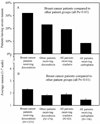Insight in the prediction of chemotherapy-induced nausea
- PMID: 19701781
- PMCID: PMC3017350
- DOI: 10.1007/s00520-009-0723-2
Insight in the prediction of chemotherapy-induced nausea
Abstract
Purpose: To identify risk factors for chemotherapy-related nausea.
Methods: We examined risk factors for nausea in 1,696 patients from three multicenter studies conducted from 1998 to 2004. All patients were beginning a chemotherapy regimen containing cisplatin, carboplatin, or doxorubicin. Nausea was assessed on a 1-7 scale four times a day for 4 days by diary.
Results: First, average nausea for breast cancer patients receiving doxorubicin (mean = 2.31) was significantly greater than for other patients receiving doxorubicin (mean = 1.82), patients receiving cisplatin (mean = 1.88), and patients receiving carboplatin (mean = 1.45), Ps < 0.01. Second, mean nausea decreased steadily with age, P < 0.0001. Third, patients rating themselves more susceptible to nausea had significantly more nausea (adjusted mean = 2.51) than patients rating themselves less susceptible (adjusted mean = 1.92) and were 2.8 times more likely to experience severe nausea, Ps < 0.0001. Fourth, expected nausea was a significant predictor of average nausea, P = 0.034, but not severe nausea, P = 0.31. Last, no evidence that gender is a significant predictor of nausea in 299 patients with gender neutral cancers, P = 0.35.
Conclusions: Specific patient characteristics, especially younger age and perceived susceptibility to nausea, can help clinicians in the early identification of patients who are more susceptible to treatment-related nausea.
Figures


References
-
- Klastersky J, Schimpff SC, Senn HJ. Supportive Care in Cancer. 2nd ed. New York: Marcel Deckker; 1999.
-
- Osoba D, Zee B, Warr D, Latreille J, Kaizer L, Pater J. Effect of postchemotherapy nausea and vomiting on health-related quality of life. The Quality of Life and Symptom Control Committees of the National Cancer Institute of Canada Clinical Trials Group. Support Care Cancer. 1997;5:307–313. - PubMed
-
- Morrow GR, Roscoe JA, Hickok JT. Nausea and Vomiting. In: Holland JC, editor. Psychooncology. New York: Oxford University Press; 1998. pp. 476–484.
-
- Hickok JT, Roscoe JA, Morrow GR, King DK, Atkins JN, Fitch TR. Nausea and emesis remain significant problems of chemotherapy despite prophylaxis with 5-hydroxytryptamine-3 antiemetics: A University of Rochester James P. Wilmot Cancer Center Community Clinical Oncology Program Study of 360 cancer patients treated in the community. Cancer. 2003;97:2880–2886. - PubMed
-
- ASHP Therapeutic Guidelines on the Pharmacologic Management of Nausea and Vomiting in Adult and Pediatric Patients Receiving Chemotherapy or Radiation Therapy or Undergoing Surgery. Am J Health Syst Pharm. 1999;56:729–764. - PubMed
Publication types
MeSH terms
Substances
Grants and funding
LinkOut - more resources
Full Text Sources
Other Literature Sources
Medical

